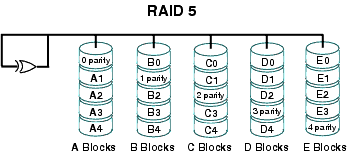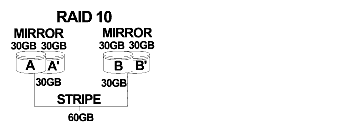



   
|
![]()
Available RAID Configurations
The following RAID levels and configurations are available for drives attached to a 3ware RAID controller:
RAID 0
Provides striping, but no mirroring or redundancy of any kind. Striped disk arrays achieve high transfer rates because they can read and write data on more than one drive simultaneously. The stripe size is configurable in the 3ware BIOS Manager (3BM) and in the 3ware Disk Manager (3DM 2). Requires a minimum of two drives.
When drives are configured in a striped disk array (see Figure "RAID 0 Configuration Example"), large files are distributed across the multiple disks using RAID 0 techniques.
Striped disk arrays give exceptional performance, particularly for data intensive applications such as video editing, computer aided design and geographical information systems.
RAID 0 arrays are not fault tolerant. The loss of any drive results in the loss of all the data in that array, and can even cause a system hang, depending on your operating system. RAID 0 arrays are not recommended for high availability systems unless additional precautions are taken to prevent system hangs and data loss.
 RAID 0 Configuration Example
RAID 0 Configuration ExampleRAID 1
Also known as a mirrored array. Mirroring is done on pairs of drives. Mirrored disk arrays write data to two drives using RAID 1 algorithms (see Figure "RAID 1 Configuration Example"). This gives your system fault tolerance by preserving the data on one drive if the other drive fails. Fault tolerance is a basic requirement for mission critical systems like web and database servers.
3ware uses a patented technology, TwinStor®, on RAID 1 arrays for improved performance during sequential read operations. With TwinStor technology, read performance is twice the speed of a single drive during sequential read operation.
The adaptive algorithms in TwinStor technology boost performance by distinguishing between random and sequential read requests. For the sequential requests generated when accessing large files, both drives are used, with the heads simultaneously reading alternating sections of the file. For the smaller random transactions, the data is read from a single optimal drive head.
 RAID 1 Configuration Example
RAID 1 Configuration ExampleRAID 5
Combines striping data with parity (exclusive OR) to restore data in case of a drive failure. This array type provides performance, fault tolerance, high capacity, and storage efficiency. Requires a minimum of three drives.
Parity information is distributed across all drives rather than being concentrated on a single disk (see Figure "RAID 5 Configuration Example"). This avoids throughput loss due to contention for the parity drive.
 RAID 5 Configuration Example
RAID 5 Configuration ExampleRAID 10
This array is a combination of RAID 1 with RAID 0. Striped and mirrored arrays for fault tolerance and high performance. Requires a minimum of four drives to use both RAID 0 and RAID 1 techniques.
When drives are configured as a striped mirrored array, the disks are configured using both RAID 0 and RAID 1 techniques, thus the name RAID 10 (see Figure "RAID 10 Configuration Example"). A minimum of four drives are required to use this technique. The first two drives are mirrored as a fault tolerant array using RAID 1. The third and fourth drives are mirrored as a second fault tolerant array using RAID 1. The two mirrored arrays are then grouped as a striped RAID 0 array using a two tier structure. Higher data transfer rates are achieved by leveraging TwinStor and striping the arrays.
In addition, RAID 10 arrays offer a higher degree of fault tolerance than other types of RAID levels (such as RAID 1 and RAID 5), since the array can sustain multiple drive failures without data loss. For example, in a twelve drive RAID 10 array, up to six drives can fail (half of each mirrored pair) and the array will continue to function. Please note that if both halves of a mirrored pair in the RAID 10 array fail, then all of the data will be lost.
 RAID 10 Configuration Example
RAID 10 Configuration ExampleRAID 50
This array is a combination of RAID 5 with RAID 0. This array type provides fault tolerance and high performance. Requires a minimum of six drives.
Several combinations are available with RAID 50. For example, on a 12-port controller, you can have a grouping of 3, 4, or 6 drives. A grouping of 3 means that the RAID 5 arrays used have 3 disks each; four of these 3-drive RAID 5 arrays are striped together to form the 12-drive RAID 50 array.
In addition, RAID 50 arrays offer a higher degree of fault tolerance than other types of RAID levels (such as RAID 1 and RAID 5), since the array can sustain multiple drive failures without data loss. For example, in a twelve drive RAID 50 array, up to one drive in each RAID 5 set can fail and the array will continue to function. Please note that if two or more drives in a RAID 5 set fail, then all of the data will be lost.
Single Disk
A single drive that has been configured as a unit through 3ware software. (3BM, 3DM 2, or CLI). Like disks in other RAID configurations, single disks contain 3ware Disk Control Block (DCB) information and are seen by the OS as available units.
Single drives are not fault tolerant and therefore not recommended for high availability systems unless additional precautions are take to prevent system hangs and data loss.
JBOD
A JBOD is an unconfigured disk attached to your 3ware RAID controller. JBOD configuration is no longer supported in the 3ware 9000 series. AMCC recommends that you use Single Disk as a replacement for JBOD, to take advantage of advanced features such as caching, OCE, and RLM.
JBOD units are not fault tolerant and therefore not recommended for high availability systems unless additional precautions are taken to prevent system hangs and data loss.
Hot Spare
A single drive, available online, so that a redundant array can be automatically rebuilt in case of drive failure.
For additional information about RAID levels, see the article "RAID Primer" on the 3ware website, at:
http://www.3ware.com/products/pdf/RAID_Primer.pdf.
Related Topics
| AMCC www.3ware.com Direct:(408) 542-8800 Toll Free: (800) 840-6055 email: 3waresupport@amcc.com |
   
Copyright (c) 2004-2006, AMCC |